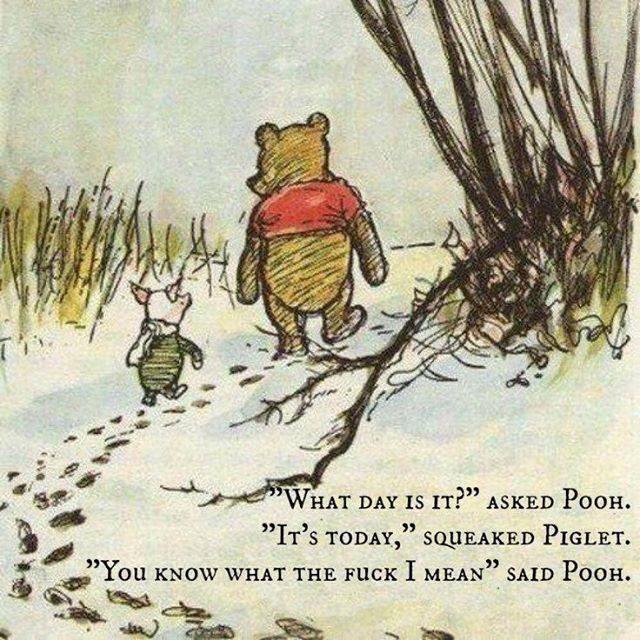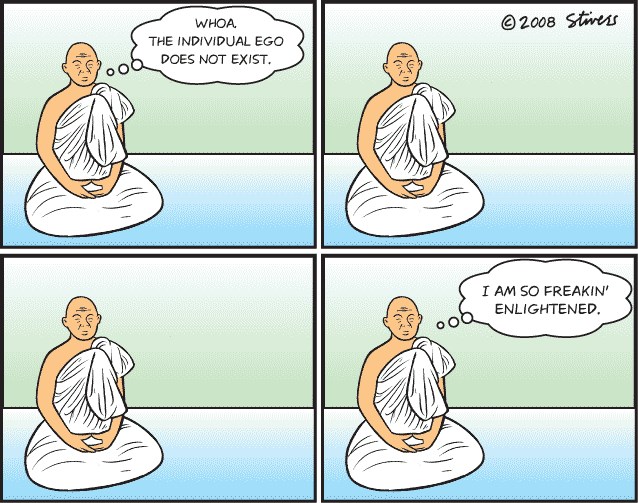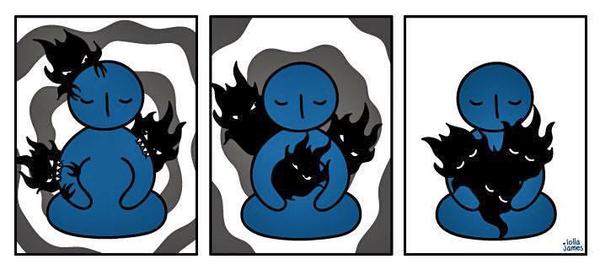Random Dharma
- Posts: 606
- Posts: 606
- Posts: 2340
I find these commonalities with meditation practices and yoga interesting:
"In the article above, vagal tone was increased through a device that stimulated the vagus nerve. The good news is that you have access to this on your own, but it does require regular practice. To some degree, you are genetically predisposed to varying levels of vagal tone, but this still doesn’t mean that you can’t change it. Here are some ways to tone the vagus nerve:
Slow, rhythmic, diaphragmatic breathing. Breathing from your diaphragm, rather than shallowly from the top of the lungs stimulates and tones the vagus nerve.
Humming. Since the vagus nerve is connected to the vocal cords, humming mechanically stimulates it. You can hum a song, or even better repeat the sound ‘OM’.
Speaking. Similarly speaking is helpful for vagal tone, due to the connection to the vocal cords.
Washing your face with cold water. The mechanism her is not known, but cold water on your face stimulates the vagus nerve.
Meditation, especially loving kindness meditation which promotes feelings of goodwill towards yourself and others. A 2010 study by Barbara Fredrickson and Bethany Kik found that increasing positive emotions led to increased social closeness, and an improvement in vagal tone.
Balancing the gut microbiome. The presence of healthy bacteria in the gut creates a positive feedback loop through the vagus nerve, increasing its tone."
- Posts: 606
- Posts: 834
- Posts: 2340
Excellent!
- Posts: 834
Practice tip: of wolves and wildebeests
Not infrequently a student who moved to another city would call me and express their frustration about a local group or center. They missed the back and forth exchange, the room to question and challenge, the freedom and encouragement to explore their own experience that they had become accustomed to at the classes and sutra sessions they had participated in at Unfettered Mind. They were frustrated because they couldn't ask certain questions, or, if they did, people would look at them with suspicion as if they had violated some unwritten protocol.
It's the difference between wildebeests and wolves, I would say, and a wolf should not hang out with wildebeests. It's not good for the wildebeests and it's not good for the wolf.
Wildebeests are about community. They create strong bonds. They do things together. They graze together, migrate together, and, when threatened, come together in a herd that is virtually impregnable to attack. And they eat grass. They like grass. Grass nourishes them.
Wolves are different. They occasionally come together to hunt, to chase down a caribou, for instance, but for the most part, they live on their own, or in very small family units, they run on their own and they hunt on their own. It's not for nothing that we have the phrase "lone wolf". And they don't eat grass.
If a wolf hangs out with a herd of wildebeests, he or she has to act like a wildebeest. That's going to work for only so long. Wolves don't find grass sustaining, let alone nourishing. Sooner or later, one of the wildebeests is going to start looking like food to the wolf and the wolf is going to attack it. Then the other wildebeests step in and make short work of the wolf.
So, it's not good for the wildebeests and it's not good for the wolf.
Needless to say, a wildebeest is not going to be happy hanging out with a wolf, either.
Most people want a spiritual dimension in their lives, but there are differences. Some want to be part of a community of practitioners and their practice takes place within that community and the rich relationships they enjoy there. Others are willing to go wherever their practice takes them, off on their own, whether into books, into retreats or into the mountains. They are not content with convention and are looking for a way to cross over into another life.
It's difficult, if not impossible, to do both, so it's good to be clear which is important to you. I've seen a lot of confused wildebeests trying to be wolves and a lot of restless wolves trying to be wildebeests.
As Uchiyama Roshi liked to say, a violet cannot bloom as a rose, and a rose cannot bloom as a violet.
Practice tip: of wolves and wildebeests, part 2
Last week's practice tip generated quite a few responses. A couple of people pointed out that wolves are highly social animals with strong family ties (as Farley Mowat describes in his groundbreaking yet very amusing classic Never Cry Wolf). Rather more people appreciated the intended symbolism and welcomed the explicit differentiation, e.g., "I wish someone had told me this 25 years ago."
This week, I go a step further. In the spirit of Lewis Carroll, it's time to talk of many things.
My training in the Tibetan tradition of Buddhism strongly fostered the possibility of the complete transcendence of the human condition. I learned methods of practice that promised the ability to transcend death and use the process of rebirth to fulfill one's bodhisattva vow. Strongly associated with this ideal was the ideal of the solitary mountain hermit free of the responsibilities of society (which were seen as mere distractions). My teacher once told me that the solitary hermit was exactly the life to which he aspired, but that he had to leave his mountain retreat when his own teacher insisted he take on the responsibility of teaching the three-year retreat at his monastery.
Despite his aspirations, my teacher was bound by the obligations of his culture. Over time I also came to observe that very few teachers actually lived alone. Some did, but only for a period of time. All the teachers I knew had at least one person with whom they had a very close relationship, sometimes a friend, sometimes an attendant, sometimes a colleague, sometimes a spouse. The solitary hermit who transcends the bounds of society seems to be as much a myth as the lone wolf.
At the same time, my observation of various Buddhist centers, traditional and non-traditional, has shown me that individuals routinely give up their own sense of path to conform to the path laid out by the group -- even when they know that it's not the right path for them. Group cohesion, often in the form of "following the tradition", is the higher priority. Frequently, unacknowledged personal preferences come to influence, if not determine, the structure and organization of the group. Gurdjieff's "It all comes down to who likes whom" seems to operate everywhere.
While some groups are better than others at maintaining a constructive practice environment (and leadership plays an important role here), I see no essential difference between Buddhist groups and other organizations, whether an association of ski instructors, a family business or a large corporation. Belonging trumps practice. The Sufis were well aware of this propensity and recognized that spiritual organizations could function effectively as practice environments for only a limited period of time before social agendas came to dominate.
Both the wolf and the wildebeest live in belief. The wolf believes that it is possible to transcend the human condition and forego all forms of relationship and social interaction. The wildebeest believes that it is possible to find freedom without changing his or her relationship with society and the network of relationships that form his or her world.
Both these are widely held beliefs. When we recognize both of them for what they are, life becomes quite interesting. Gone is our belief in a personal transcendence. Gone is our belief in a place where we belong. For some, life without either of these beliefs is unimaginable. For others, it is the beginning of freedom.
Having trouble containing your grief at the office? Struggling with the uncertainty of your position during the 7th restructure in as many years? Do some mindfulness. It’ll fix not so much what ails you, but what is ailing those who depend on you. Rather than a difficult but easily accessible way to free your mind and body, mindfulness has been rebranded as a kind of gentle harness to help us heel to the corporate leg.
- Posts: 1570
- Posts: 1570
- Posts: 1139
Laurel Carrington wrote: A good read. I should say, though, that the sangha here, while of the wildebeest type, is small and eclectic, and a person with a more transformative practice can hang out. The one in Minneapolis has some realized people, including the lead teacher, who nonetheless understand that most people aren't ready for or interested in such a thing. They still talk about awakening, however, and there's an overall respect paid to the path. So it's not always as cut and dried as this analogy suggests.
Agreed - 'there are two types of people' models tend to be oversimplifications
For some, life without either of these beliefs is unimaginable. For others, it is the beginning of freedom.
- Posts: 1139
In all decisions, Stanovnik governs according to a rule of thumb that he has developed over the years: at the dark moment when Robic feels utterly exhausted, when he is so empty and sleep-deprived that he feels as if he might literally die on the bike, he actually has 50 percent more energy to give.
‘‘That is our method,’’ Stanovnik says. ‘‘When Jure cannot go any more, he can still go. We must motivate him sometimes, but he goes.’’
In this dual-brain system, Robic’s mental breakdowns are not an unwanted side effect, but rather an integral part of the process: welcome proof that the other limiting factors have been eliminated and that maximum stress has been placed firmly on the final link, Robic’s mind. While his long-term memory appears unaffected (he can recall route landmarks from year to year), his short-term memory evaporates. Robic will repeat the same question 10 times in five minutes. His mind exists completely in the present.
www.nytimes.com/2006/02/05/sports/playma..._r=5&pagewanted=all&
- Posts: 6503
- Karma: 2
- Posts: 1139
- Posts: 1139
- Posts: 1139
"Of all the questionable assumptions that prop up the Myers-Briggs indicator, this one strikes me as the shakiest: that you are "born with a four letter preference," a reductive blueprint for how to move through life's infinite and varied challenges. Many other personality indicators, ranging in complexity from zodiac signs to online dating questionnaires to Harry Potter's sorting hat, share the assumption that personality is fixed in one form or another. And yet the belief of a singular and essential self has always seemed to me an irresistibly attractive fiction: One that insists on seeing each of us as a coherent human being, inclined to behave in predictable ways no matter what circumstances surround us. There is, after all, a certain narcissistic beauty to the idea that we are whole. "If personality is an unbroken series of successful gestures, then there was something gorgeous about him, some heightened sensitivity to the promises of life," wrote F. Scott Fitzgerald of his greatest creation, Jay Gatsby, in the same year that Katharine fell under the sway of Psychological Types. Learning to speak type means learning to link the quotidian gestures of life into an easily digestible story, one capable of communicating to perfect strangers some sense of who you are and why you do what you do.
Yet the impulse to treat personality as innate is, in no small part, a convenient way of putting these gorgeously complete people in their rightful places. Just as each one of Isabel's three detectives serves a unique purpose in her novels, a way of moving the plot forward that follows from his innate "gifts," so too does the indicator imagine that each person will fall into their designated niche in a high-functioning and productive social order."
- Posts: 606
self appendectomy - graphic images of a man performing surgery on himself!





